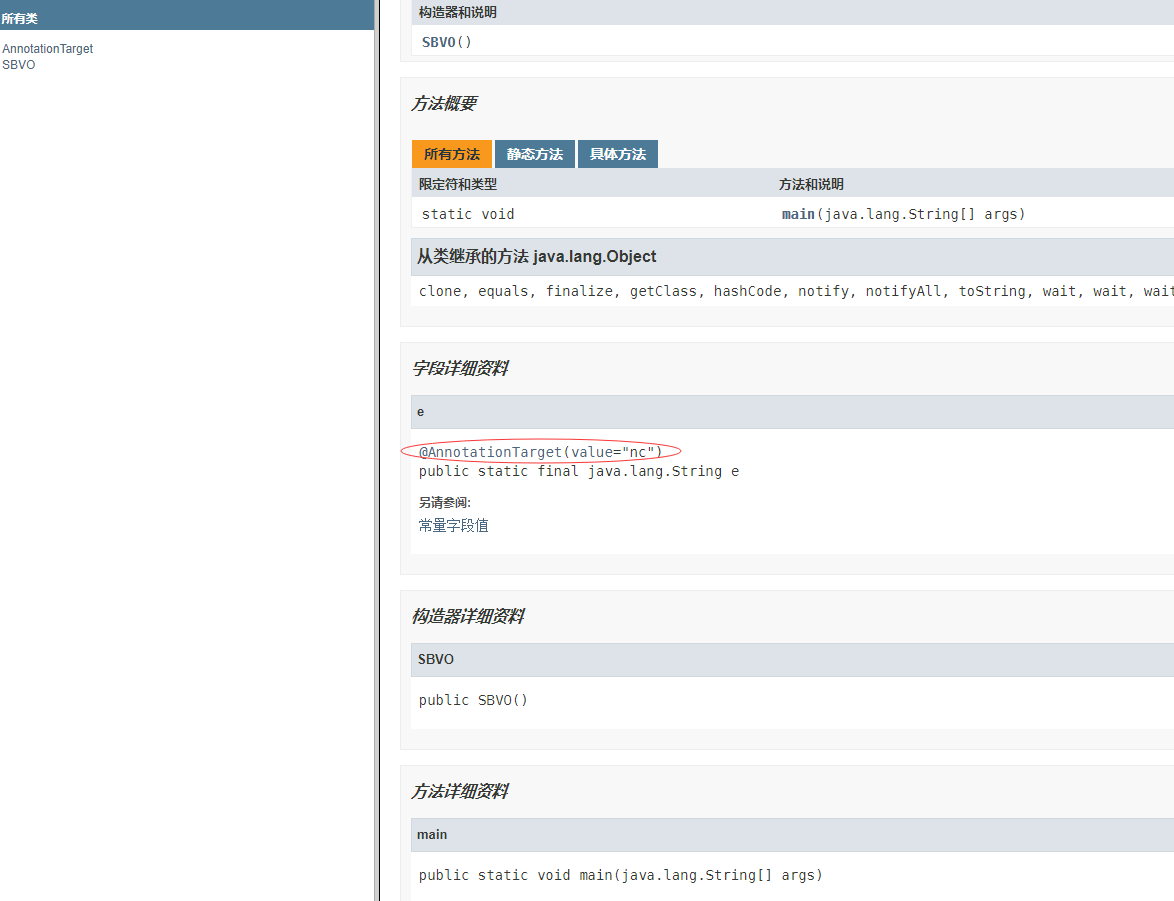自JDK1.5之后,就开始出现注解。想要了解注解的来源和注解的用法,通过搜索引擎大都是针对某一个注解的解释,很难找到关于注解系列的文章,便自己看下。
基于Annotation的注释,说明Annotaion是所有注解类型扩展的公共接口。当自定义为@inferface便实现该接口。可用 instanceof去校验@interface是否属于Annotation.而上面的Target属于注解其它的注解的元注解。元注解有四个:Target、Retention、Documented、
Inherited。
Target
TYPE: 类
FIELD: 字段
METHOD: 方法
PARAMETER: 参数
CONSTRUCTOR: 构造函数
LOCAL_VARIABLE:本地变量
ANNOTATION_TYPE:注解
PACKAGE:包
现在演示一下Target
自定一个注解,作用于FIELD的:
@Target(ElementType.FIELD)
@Retention(RetentionPolicy.RUNTIME)
@Documentedpublic @interfaceAnnotationTarget {
String[] value()default "iamsb";
}
被标记的字段拥有了超能力,是的,其它的字段仍然很傻,以下是被标记的字段赋予超能力的过程
public classAnnotationTargetProcessor {public static voidprocess(Class clazz, Object obj) {
Field[] fields=clazz.getDeclaredFields();for(Field field : fields) {if(field.isAnnotationPresent(AnnotationTarget.class)){try{
field.setAccessible(true); // 被注解的字段是private ,所以设置true
field.set(obj,"now,i am still sb");
}catch(IllegalArgumentException e) {//TODO Auto-generated catch block
e.printStackTrace();
}catch(IllegalAccessException e) {//TODO Auto-generated catch block
e.printStackTrace();
}
}
}
}
}
最后的测试类
public classSBVO {privateString a;privateString b;
@AnnotationTarget("zz")privateString c;privateInteger d;private Boolean bool = false;public static voidmain(String[] args) {
SBVO sv= newSBVO();
AnnotationTargetProcessor.process(SBVO.class,sv);
String c=sv.c;
String b=sv.b;
System.out.println("c ==== " +c); // c ==== now,i am still sb
System.out.println("b ==== " +b); // b ==== null
}
}
说明:1.@AnnotationTarget声明的是@Target(ElementType.FIELD),所以在用注解的时候,只能作用于字段上,而当你把@AnnotationTarget("zz")想放在类上面时,编译都不让你过,提示:The annotation @AnnotationTarget is disallowed for this location
2.注解本身不具备超能力,它本身属于被动的。而是我们的规则处理类发现某个元素有某种注解,就按照某种规则来给这个元素赋予某种能力。比如我上面的AnnotationTargetProcessor扫描到字段c 有个AnnotationTarget注解,那我就给与你什么能力。同理,springboot的
某个类(目前不知道是哪个)发现有个类被标记了@Service,那我就把它来赋予Service能力。
3.@interface里面只能定义返回类型为 所有基本类型、String、enum、Annotation、Class和 它们的数组。
4.用注解的时候,跟我们调用方法一样 注解名(元素名=元素值),比如我们springboot的启动类 @SpringBootApplication(scanBasePackages = "xxxx",exclude={xxx.class,yyy.class}) ,可以查到SpringBootApplication注解下scanBasePackages和exclude
元素。
5.@AnnotationTarget("zz")这里要说一下,这个原本是这样:@AnnotationTarget("value=zz"),如果声明的注解里只对value赋值,那么在引用的时候value=可以省略。
接着再看下元注解
Documented
它没有元素,所以也被称为标记注解,我在SBVO中添加一行代码:
@AnnotationTarget("nc")public static final String e = "SPRING SUMMER";
然后用javadoc -encoding UTF-8 AnnotationTarget.java SBVO.java 生成文档,这里我的类里面有中文,所以添加了utf8方式,生成的doc文档,入口是index.html,见下图:

就是标红椭圆的注解是否被添加到doc文档的差别。如果没有添加元注解Documented,这里是没有红色椭圆的文本信息的。所以定义了Documented的自定义注解,在生成javadoc文档时,就会添加该注解文本信息。
接着看
Retention
public enumRetentionPolicy {/*** Annotations are to be discarded by the compiler.*/SOURCE,/*** Annotations are to be recorded in the class file by the compiler
* but need not be retained by the VM at run time. This is the default
* behavior.*/CLASS,/*** Annotations are to be recorded in the class file by the compiler and
* retained by the VM at run time, so they may be read reflectively.
*
*@seejava.lang.reflect.AnnotatedElement*/RUNTIME
}
1.SOURCE ,编译器将丢弃注解
2. CLASS,编译器将在类文件中记录注解,但是不需要在运行时被VM保留。这是默认值的行为。
3. RUNTIME,编译器将在类文件中记录注解,并且在运行时被VM保留。因此在反射时可以读取得到它们。
作何解释呢?我先把我自定义注解AnnotationTarget的保留策略改成RetentionPolicy.SOURCE
@Target(ElementType.FIELD)
@Retention(RetentionPolicy.SOURCE)public @interfaceAnnotationTarget {
String[] value()default "iamsb";
}
仍然用下面这个类来引用它
public classSBVO {privateString a;privateString b;
@AnnotationTarget("zz")privateString c;privateInteger d;private Boolean bool = false;
@AnnotationTarget("nc")public static final String e = "SPRING SUMMER";
@AnnotationTarget("")private String f = "i do not want to be a sb.";public static voidmain(String[] args) {
SBVO sv= newSBVO();
AnnotationTargetProcessor.process(SBVO.class,sv);
String c=sv.c;
String b=sv.b;
String f=sv.f;
System.out.println("c ==== " +c);
System.out.println("b ==== " +b);
System.out.println("e ==== " +e);
System.out.println("f ==== " +f);
}
}
经过编译后,把引用的SBVO.class反编译,可以看到
public classSBVO
{privateString a;privateString b;privateString c; // 未保留privateInteger d;private Boolean bool = Boolean.valueOf(false);public static final String e = "SPRING SUMMER"; // 未保留private String f = "i do not want to be a sb."; // 未保留public static voidmain(String[] args)
{
SBVO sv= newSBVO();
AnnotationTargetProcessor.process(SBVO.class, sv);
String c=sv.c;
String b=sv.b;
String f=sv.f;
System.out.println("c ==== " +c);
System.out.println("b ==== " +b);
System.out.println("e ==== SPRING SUMMER");
System.out.println("f ==== " +f);
}
}
这里就解释了策略为SOURCE时,编译后就把注解丢弃了。
当我把策略改成RetentionPolicy.CLASS,编译后再来看SBVO.class
public classSBVO
{privateString a;privateString b;
@AnnotationTarget({"zz"})privateString c; // 保留了注解privateInteger d;private Boolean bool = Boolean.valueOf(false);
@AnnotationTarget({"nc"})public static final String e = "SPRING SUMMER"; // 保留了注解
@AnnotationTarget({""})private String f = "i do not want to be a sb."; // 保留了注解public static voidmain(String[] args)
{
SBVO sv= newSBVO();
AnnotationTargetProcessor.process(SBVO.class, sv);
String c=sv.c;
String b=sv.b;
String f=sv.f;
System.out.println("c ==== " +c);
System.out.println("b ==== " +b);
System.out.println("e ==== SPRING SUMMER");
System.out.println("f ==== " +f);
}
}
此时我来运行SBVO的main 方法,得到结果:
c ==== null
b ==== null
e ==== SPRING SUMMER
f ==== i do not want to be a sb.
此时main方法里面的AnnotationTargetProcessor.process(SBVO.class, sv); 其中process方法if(field.isAnnotationPresent(AnnotationTarget.class)) 判断始终是false,反射取不到,说明注解没在虚拟机中驻留。所以,c、b、e、f都是原值,那我在把自定义注解
AnnotationTarget策略更改成RetentionPolicy.RUNTIME,首先注解时保留在SBVO.class文件中的
@AnnotationTarget({"zz"})privateString c; // 保留privateInteger d;private Boolean bool = Boolean.valueOf(false);
@AnnotationTarget({"nc"})public static final String e = "SPRING SUMMER"; // 保留
@AnnotationTarget({""})private String f = "i do not want to be a sb."; // 保留
然后,运行SBVO中的main方法,结果为:
java.lang.IllegalAccessException: Can not set static final java.lang.String field studiii.zlsj_test.annotation.target.SBVO.e to java.lang.String
at sun.reflect.UnsafeFieldAccessorImpl.throwFinalFieldIllegalAccessException(Unknown Source)
at sun.reflect.UnsafeFieldAccessorImpl.throwFinalFieldIllegalAccessException(Unknown Source)
at sun.reflect.UnsafeQualifiedStaticObjectFieldAccessorImpl.set(Unknown Source)
at java.lang.reflect.Field.set(Unknown Source)
at studiii.zlsj_test.annotation.target.AnnotationTargetProcessor.process(AnnotationTargetProcessor.java:19)
at studiii.zlsj_test.annotation.target.SBVO.main(SBVO.java:30)
c ==== now,i am still sb // c 由空值改成当前值
b ==== null // b 未添加注解
e ==== SPRING SUMMER //final 改不了,上面也抛异常了
f ==== now,i am still sb //f 值由 i do not want to be a sb.改成 now,i am still sb
此时看到AnnotationTargetProcessor.process通过反射把标记了注解的字段都更改了,e标记了注解,但e是final变量,所以当想要更改它时,是不允许的。接着看最后一个
Inherited 从它的源码可以看到,它没有定义任何元素,所以它和Documented一样,属于标记注解。再来看一下它的注释:
/*** Indicates that an annotation type is automatically inherited. If
* an Inherited meta-annotation is present on an annotation type
* declaration, and the user queries the annotation type on a class
* declaration, and the class declaration has no annotation for this type,
* then the class's superclass will automatically be queried for the
* annotation type. This process will be repeated until an annotation for this
* type is found, or the top of the class hierarchy (Object)
* is reached. If no superclass has an annotation for this type, then
* the query will indicate that the class in question has no such annotation.
*
*
Note that this meta-annotation type has no effect if the annotated
* type is used to annotate anything other than a class. Note also
* that this meta-annotation only causes annotations to be inherited
* from superclasses; annotations on implemented interfaces have no
* effect.
*
*@authorJoshua Bloch
*@since1.5
* @jls 9.6.3.3 @Inherited*/
翻译一下:表明它是一个自动继承的注解类。如果一个声明的注解类(自定义注解)上存在这个继承元注解,并且用户去查找某个声明类上的自定义注解,并且这个声明类没有这个自定义注解,那么将自动去搜索这个类的父类的自定义注解。这个过程将
重复,直到这个自定义注解被找到,或者搜索直到这个声明类的最顶层Object类。如果没有父类(这里指父、祖父、曾祖父直到Object)含有自定义注解,那么就表明这个声明类没有这个自定义注解。
注意,如果自定义注解不是注释在一个类上的话,这个元注解(指Inherited)是没有效果的。还注意,这个元注解只会导致注解被继承自超类,实现接口上的注解是无效的。
再翻译一下:1.这是一个自动继承的元注解,它是注解自定义注解的注解。
2.如果某个类的父类、或者祖父类等有@Inherited注解或含有@Inherited的自定义注解,那么子类便可继承父类的注解。
3.该注解只对类有效,对接口实现是无效的。
例子:
创建一个注解,标记Inherited
@Retention(RetentionPolicy.RUNTIME)
@Inheritedpublic @interfaceInheAnnoTest {
String value()default "ni da ye";
}
创建一个父类
@InheAnnoTest("Just Parent")public classParentClass {privateString name ;
@AnnotationTarget("yes, i am 15")
String age;
@MethodTestAnno("yeah")public voidattack() {
}
@InheAnnoTest("ojbk")protectedString plus() {return "";
}
}
创建一个子类
public class ChildClass extendsParentClass {privateString name ;
String age;public voidattack() {
}protectedString plus() {return "plus";
}
}
测试类
public classTest {/***@paramargs*/
public static voidmain(String[] args) {//TODO Auto-generated method stub
Class cc = ChildClass.class;
Class pc = ParentClass.class;
System.out.println(pc.isAnnotationPresent(InheAnnoTest.class)); // true
System.out.println(cc.isAnnotationPresent(InheAnnoTest.class)); // true
Annotation[] annos=cc.getAnnotations();for(Annotation anno : annos) {
System.out.println(anno.annotationType().getName()); // studiii.zlsj_test.annotation.inheritedTest.InheAnnoTest
}
}
}
如果ChildClass和ParentClass 无继承关系,那么
System.out.println(cc.isAnnotationPresent(InheAnnoTest.class)); // false
并且 annos 就为空了。
再来验证接口,创建一个接口:
@InheAnnoTest("") // 打上了标记public interfaceParentInterface {public static final String name = "daye";voidatack();
}
实现类:
public class ChildInterface implementsParentInterface{
@Overridepublic voidatack() {
}
}
得到结果:
Class ci = ChildInterface.class;
System.out.println(ci.isAnnotationPresent(InheAnnoTest.class)); // false
因此,就印证了Inherited注释里得说明。
总结一下:注解Annotation 从JDK1.5之后被引入。它包含了4个元注解:Tagert、Documented、 Retention、 Inherited,元注解的意思就是可以注解其它注解的注解。就好比我们拼音有6个元音 a、o、e、i、u、u(..),可以组成很多双韵母,比如ai、ei、ui、ao、ou等等,进而拼出
中华上下五千年沉淀的各种汉字。同理,4个元注解也可衍生出各种功能的注解。
Tagert注解指明你定义的注解的作用域,是Field、Method还是Type等。
Documented注解表示通过javadoc后,会再doc中显示出来。
Retention注解,表示注解的保留策略,仅有三种,1.编译时就把注解丢弃。2.编译时保留,但再JVM中不保留。3.编译时保留,JVM中也保留,反射可从JVM中取到该注解。Inherited注解,表示子类可以取到父类中定义了该注解的注解。





















 190
190











 被折叠的 条评论
为什么被折叠?
被折叠的 条评论
为什么被折叠?








